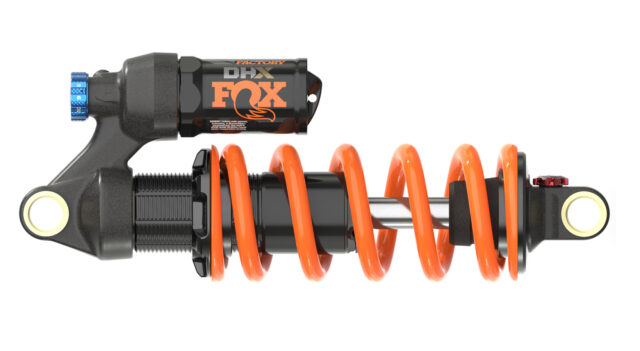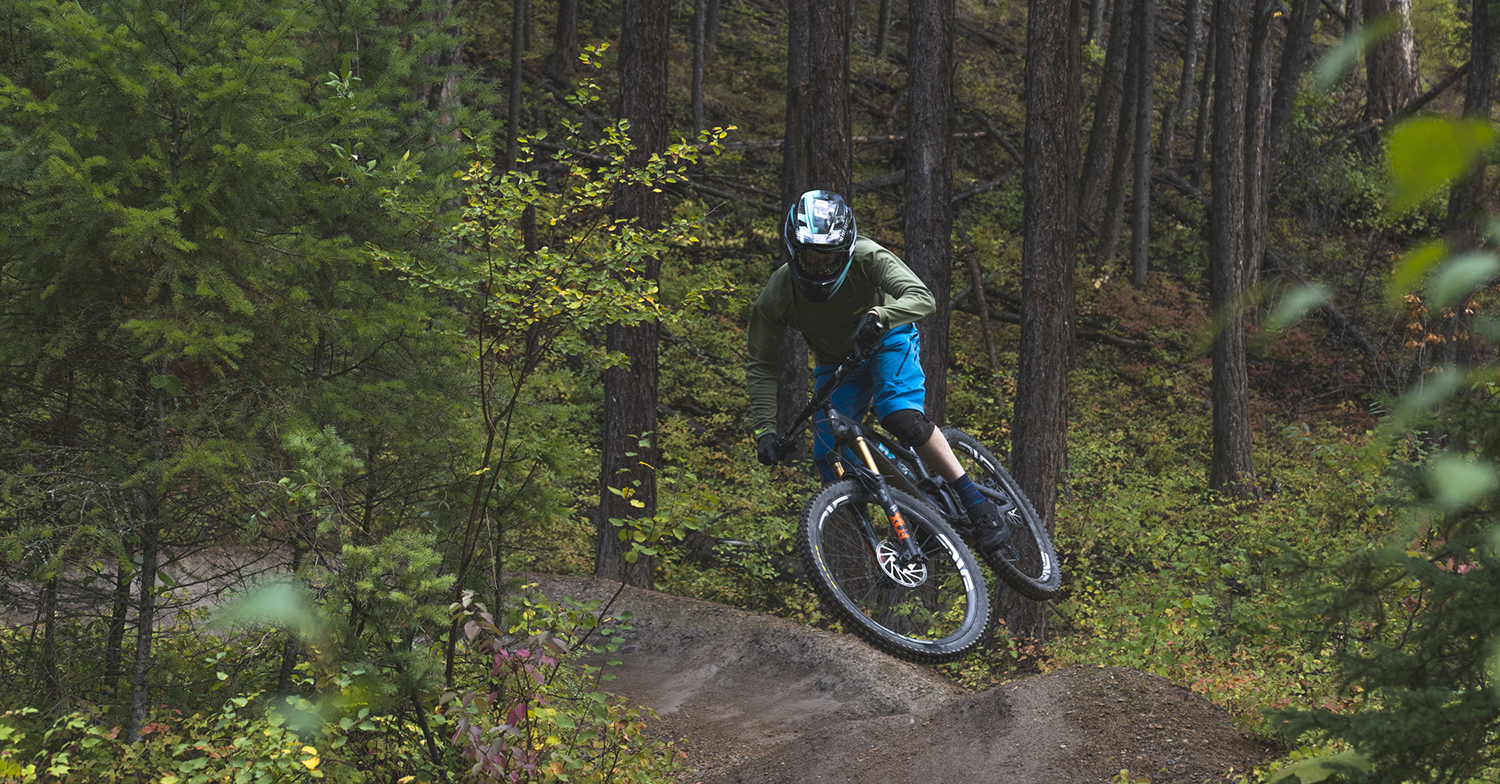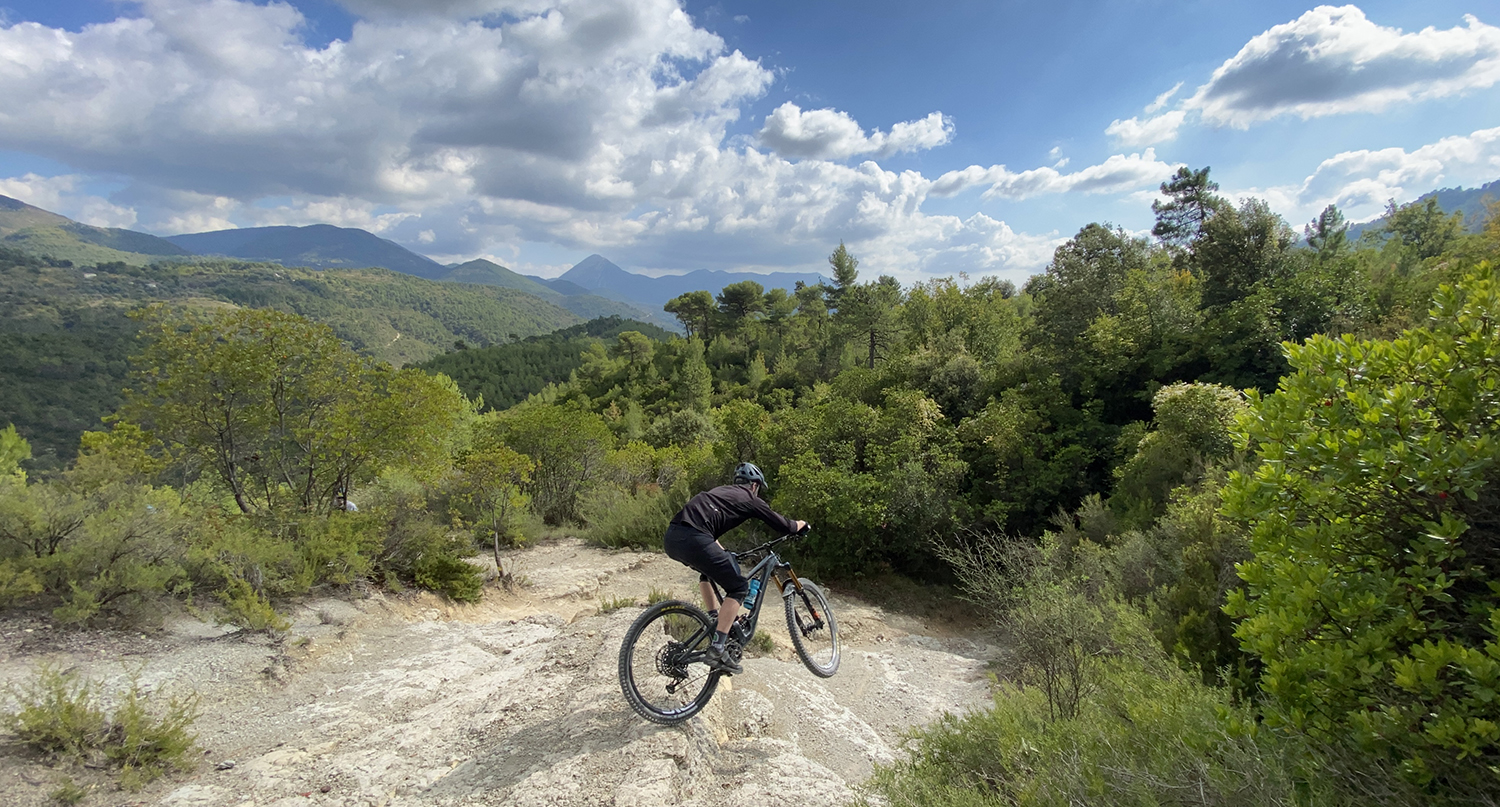2022 Fox DHX
Test Location: Montana, France, Italy
Test Duration: 4 months
Size Tested: 205 x 60mm, trunnion
Mounted to: Specialized Enduro
Blister’s Measured Weight:
- Shock body: 509 g
- 475 lb SLS spring: 442 g
- Total shock weight: 951 g
MSRP: $569 (w/o spring)
Reviewer: 5’9”, 160 lbs / 175 cm, 72.6 kg

Intro
The Fox DHX is a new shock for Fox for 2022 — while it shares (most of) its name with the venerable DHX2, it’s a different shock with different internals and isn’t intended to replace the DHX2. The new DHX is the coil complement to the (also new) Fox Float X, which is air sprung but features the same damper as the DHX.
So what’s the story with the DHX? There are some differences in the damper that we’ll get into below. And it’s a bit cheaper than the DHX2. And the adjustments are a bit different than the DHX2. But who should get one over the other? And does that all add up to something awesome? The answer is a bit murky.
Options and Features
The DHX is available in metric sizes only, with an assortment of common lengths and strokes in both standard and trunnion mounts. The lack of imperial sizing might leave some upgraders out of luck, but the DHX will fit a pretty wide range of modern bikes.
Unlike the DHX2, all external adjustments are tool free, although there are fewer of them. You get a nice climb switch on an independent circuit from the main compression damper path, a low-speed rebound dial, and a low-speed compression dial that has clicks numbered on it 0–10. As with anything Fox, compression adjustments are counted in terms of clicks from fully closed, but this creates a bit of confusion on the compression dial since “0” is the firmest compression damping setting, and “10” is the lightest. The spring collar also has detents on it, which are nice both for keeping the preload from creeping loose, and for counting turns.

The Damper
The damper is the primary difference between the DHX and DHX2 — namely, the DHX is a single-tube damper, whereas the DHX2 is a twin-tube damper. As an aside, this is also a difference between the new Fox Float X and DPX2 — the Float X shares the single-tube damper of the DHX, whereas the DPX2 and Float X2 shocks use twin-tube dampers. Incidentally, the Fox RC4 (which was replaced by the Fox DHX2), was also a single-tube shock like the new DHX, so single-tube dampers aren’t new to Fox — but the return to them in some of their higher-end, burlier rear shocks is something of a reversal.
The main difference between a single- and twin-tube damper is that, in a single-tube damper, oil is pushed back and forth through the main piston head, and much of your damping force comes from the valving there. In a twin-tube damper, oil is pushed up by the main piston head, through the damper valves, and then recirculates down through a second tube (the “twin” tube) to the back side of the main piston head.
This can all get pretty complicated, so I’ll let the pros at Vorsprung explain it a bit more concisely — the visuals in their video on the subject definitely help.
The quick and dirty takeaways are that, in a perfect world, either damper style can yield the same performance, and perfection really comes down to the valving and tune of each specific damper. Twin-tube dampers have the advantage of being a bit more suited to a wide range of external adjustability, and they can have a narrower shock shaft that has smaller seals and less friction. Single-tube dampers can be a little simpler and have a bigger shock shaft that might hold up better to lateral loads, which can be especially troublesome on bikes that use a yoke to extend the rear shock.

The Ride
So with all of that tech talk behind us, how does the DHX actually do on the trail?
For my test, I had the DHX mounted up to a Specialized Enduro, which uses a 205 x 60 trunnion mount. The Enduro’s suspension has a relatively progressive leverage rate, so it’s well suited to a coil shock. My DHX came set up with a 475-pound spring that yielded a sag of about 31% for me, which is about where I was running the Float X2 that I previously had on the bike.
Fit and finish on the DHX are clean, and mounting the shock went entirely smoothly. The dials are easy to access and easy to turn, and I’m a big fan of the climb switch. The switch is bigger than the one on the DHX2 / Float X2, and it’s easier to actuate. When locked, it’s a fairly soft lock, which is great for maintaining traction on rooty climbs, but less great for efficiency.
[David Golay: I’ve also been spending some time on the Float X (review coming soon) and just got on a DHX, and my take on the climb switch is a little different than Noah’s. It’s maybe not the firmest one out there (at least on the couple of shocks I’ve been on — it’s possible that Noah’s is valved differently), but it is significantly firmer than the ones on any of the 2021/22 Float X2s or DHX2s that I’ve been on.]
For initial setup, I started with the compression wide open, and worked on getting the rebound dialed in. Normally, rebound for me (particularly on a shock with only a low-speed rebound adjustment) is a “set and forget” kind of thing, but I actually struggled a bit with the rebound settings on the DHX. I found the adjustments to be a bit too coarse — I wanted some additional fine-tuning in between each click. I came to grips with it, but I’d rather see some finer gradations in the rebound adjustments.
With the rebound in the right ballpark, I set off for some lift-served laps in the local bike park. And right out the gate, the small-bump sensitivity of the DHX was really, really impressive. The Float X2 that I previously had on the bike certainly isn’t bad at ironing out the trail, but the DHX is on a whole different level. Small chatter is effectively erased, and the amount of traction that the bike maintains through chunky corners is incredible. Great small-bump sensitivity is somewhat expected from a coil shock, but this was better than I’d expected, and better than most other coils I’ve ridden.

Now, small-bump sensitivity is great, but it sometimes comes at the expense of mid-stroke support. So is that the case with the DHX? Well, sort of. For moderate pumping, like through a quick corner, the DHX actually holds up pretty well. It’s not as supportive as the Float X2, but it isn’t a complete mushy mess, either.
But if you push into the shock a little harder, all of a sudden that support disappears. The DHX has a fairly distinct difference in the feel through the first half of the stroke compared to the second half of the stroke. The first half is fantastic — great sensitivity, and reasonable support. The second half leaves quite a bit to be desired — not much in the way of support, and it was getting utterly crushed on big impacts (although there was never a harsh “clang” — the DHX has a great bottom-out bumper).
Dialing up the compression adjustment helped this a bit — I ended up running the DHX’s compression 2–3 clicks from fully closed to try to get more support and to help out on those big impacts. If I closed the damper any more than that, it started getting pretty harsh throughout its travel. Now, the only external adjustment is for the low-speed circuit, and really for big impacts I’d rather be adjusting the high-speed compression circuit, but that’s not an option in the DHX without re-valving it.
This conundrum sent me down the rabbit hole of progressive springs — I ended up running a 450-pound progressive spring from MRP, which preserved the DHX’s nice small-bump sensitivity but had enough ramp-up at the end to deal with big impacts a bit more gracefully. It also let me open up the compression adjustment a bit (6–7 clicks from closed). But to be clear, the Enduro has a progressive enough leverage ratio that it shouldn’t need a progressive spring — I think the issue is the tune of the shock. The progressive spring is just a bandaid solution.
I also had an issue with what I can only describe as a spring rattling sound — kind of like if the preload adjustment is a turn too loose and the spring rattles around a bit. Except the spring wasn’t rattling around — I did lots of double checking, but the sound persisted. And the sound was the same with four different springs that I tried. I also couldn’t replicate the sound in the shop — I only hear it while riding. And I can’t say that it clearly correlates with anything I feel from the shock — it’s mostly just annoying. But I also know other people who are riding the DHX shock that aren’t having this issue, so this may have just been something wonky with my shock.

Comparisons
Comparing rear shocks is tricky because getting a good, apples-to-apples comparison really requires running different shocks on the same frame. Every frame’s suspension design is different, and many shocks are tuned for that specific bike, all of which makes comparing different shocks on different bikes pretty tricky.
But with that in mind, here are a couple comparisons to other shocks that I’ve ridden on the same Specialized Enduro that I rode with the DHX:
Fox Float X2: The Float X2 is an air shock that uses the same twin-tube damper design as the DHX2, and I would generally rate the Float X2 as one of the most Downhill-worthy air shocks on the market. The Float X2 is more tunable than the DHX in that it has both high- and low-speed adjustments for both the rebound and compression circuits. At the risk of stating the obvious, it’s also adjustable via the air pressure, and you can add volume reducers to adjust the ramp-up.
Compared to the Float X2, the DHX has far better small-bump sensitivity, but far worse bottom-out control. The Float X2 is more supportive throughout its travel, although the DHX isn’t that far behind for the first half of its stroke. Still, though, the Float X2 is generally more effective for pumping and popping off of lips. The Float X2 also pedals better, partly because it’s not as sensitive to small movements, and partly because the lockout lever is a smidge firmer.
Push Elevensix: This is a somewhat silly comparison because the DHX costs less than half as much as the Elevensix, but I’ve ridden an Elevensix that was custom-tuned for the Enduro, so I might as well talk about it. The Elevensix is much more supportive through its travel and is one of the best shocks I’ve ever ridden (coil or air) in terms of mid-stroke support. The Elevensix also does a really impressive job of handling big square impacts — it somehow makes huge hits feel a lot less huge.
But the Elevensix had fairly unimpressive small-bump sensitivity. I’d maybe even go so far as to call it bad. The DHX was far better at ironing out chatter in the trail and maintaining traction through choppy corners. While it should be pretty clear that I think the DHX has some tuning issues, I would maybe, tentatively, kind of, sort of, pick the DHX over the Elevensix (with the caveat that I need the MRP progressive spring on the DHX to make it work for me). To put it another way, given the price, I expected the Elevensix to be incredibly perfect and instead, I thought it was just ok. The DHX was also just ok (albeit in a very different way), but the DHX costs half as much.
Fox DHX2: Ok, I’m ignoring my own caveat here, because I haven’t ridden the DHX2 on the Enduro (but I have ridden it on a bunch of other bikes — mostly the prior version of the DHX2, but a bit of the new 2021+ version, too). It’s the most obvious competitor to the DHX, though, so here it is. Like the Float X2, the DHX2 is more adjustable (high- and low-speed compression and rebound, vs. only low-speed compression and rebound on the DHX). The DHX2 is also a bit lighter.
I’ve always had good luck with DHX2 shocks and feel like they’re a fairly well-rounded unit. The DHX (somewhat surprisingly) might do a bit better in the small-bump sensitivity department, but the DHX2 wins out in pretty much every other metric. It’s more supportive, handles big impacts better, and still does quite well over small bumps. The DHX is cheaper, but personally, I’d spend the extra $110 for the DHX2.
Bottom Line
The Fox DHX has a lot of potential as a less expensive coil option for the ever-growing crop of big-travel bikes that still pedal uphill (Enduro bikes, if you will). While I certainly missed the adjustability of the DHX2, I certainly didn’t mind the tool-free adjustments on the DHX, and its small-bump sensitivity and ground-hugging traction are among the best I’ve ever ridden. I think the tune on my shock missed the boat in terms of big impacts and late-mid-stroke support, but I doubt that’s an inherent issue with the design of the shock. Rather, I think that’s an issue with the particular tune that I had on the particular bike I had. I’ve spoken with other people running the DHX on different frames that aren’t having the same sort of bottom-out issues I had, which tells me that I probably just needed a different tune.
So, at least for now, I’m cautiously optimistic about the DHX. It’s Fox’s first year with the shock, and it might take a year or two to get the tunes dialed for it. But for the moment, I don’t think it’s there yet — I would stick to the tried and true (and quite good) DHX2.
Honestly I think you’re too soft on spring rate, i’m same weight on an enduro and I have a 500 lb spring and its perfect.